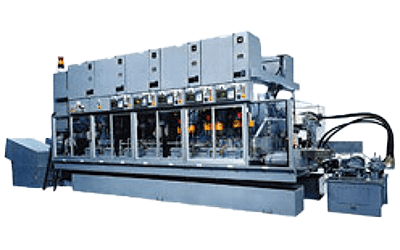What Is a Multitasking Machine?

A multitasking machine is a machine that combines an NC lathe and a machining center.
It can perform multiple machining processes at once with high accuracy. In general, multitasking machines that combine lathe and machining center functions can perform multiple angles of machining on the same workpiece, thereby reducing machining time, increasing work efficiency, and improving quality. Moreover, the two machines do not need to be installed separately, allowing for more efficient use of space.
There are two types of multitasking machines: those that mainly use machining centers and those that mainly use NC lathes. The machining center-driven type is more accurate than the lathe-driven type and is suitable for machining complex shapes. On the other hand, the NC lathe-driven type is suitable for machining large-diameter parts and parts with a high small-diameter-to-length ratio.
Multitasking machines allow multiple processes to be handled at once, simplifying the process, increasing work efficiency, and improving quality. It also improves space efficiency in the factory because it reduces the number of places to place machines. It is important to select the appropriate multitasking machine according to the size, shape, and material of the workpiece.
Uses of Multitasking Machines
A multitasking machine is a machine that combines several functions into one and is capable of a wide variety of machining operations. As a result, they are used in a wide range of fields, including automotive and aircraft parts, medical devices, and industrial equipment.
Multitasking machines are particularly suited for manufacturing parts that require complex shapes and high-precision machining. For example, multitasking machines are needed to process high-strength aluminum alloys and titanium alloys for aircraft parts. They are also used in the medical field to manufacture precision parts such as artificial joints and dental implants.
Furthermore, multitasking machines can increase productivity. Combining multiple machining functions into one simplifies the machining process and reduces work time, thereby improving productivity. Another advantage of using a single machine for multiple machining functions is that it takes up less space.
Principle of Multitasking Machines
Multitasking machines are available in two types: machining center-based types and turning center-based types, which are mainly NC lathes. The machining center-based type has a rotary table that enables turning operations, while the turning center-based type has an NC lathe spindle and integrates multiple machining functions by attaching tools.
Both types contribute to saving factory space and shortening process procedures and are suitable for machining various shapes.
1. Machining Center Base Type
The machining center-based type has cutting functions as a conventional machining center, and the rotary table rotates like a lathe, enabling turning operations. The latest models can control 5 axes simultaneously and complete machining in a single process. This type is suitable for machining large objects and can shorten the process procedure.
2. Turning Center Base Type
The turning center-based type has the main spindle of the NC lathe, and the spindle is stopped and rotated at an arbitrary angle. Tools are mounted on the turret, and functions such as drilling, boring, and milling can be added.
The opposed dual-spindle models automatically pass to the second axis for full machining after machining is completed on the first axis, thus improving machining accuracy since machining is completed in a single installation.
Other Information on Multitasking Machines
Machines used in combination with Multitasking Machines
Multitasking machines are capable of advanced machining, but they cannot complete machining by themselves. Three types of machines can be used in combination with multitasking machines.
1. Measuring Machine
After machining with a multitasking machine, there are measuring instruments to measure its accuracy. For example, there are 3D measuring instruments and shape measuring instruments, which can measure the shape with high accuracy. By using measuring instruments together, machining accuracy can be checked.
2. Tool Presetter
Multitasking machines can use multiple tools, but changing those tools can be time-consuming. The tool presetter can be used to align tools in advance before changing them. This reduces tool change time and improves productivity.
3. Other
Since machining operations on multitasking machines are often monotonous and heavy, robots are sometimes combined. For example, they can automatically attach tools and move workpieces. In addition, multiple multitasking machines can be linked together to produce products automatically.